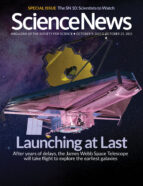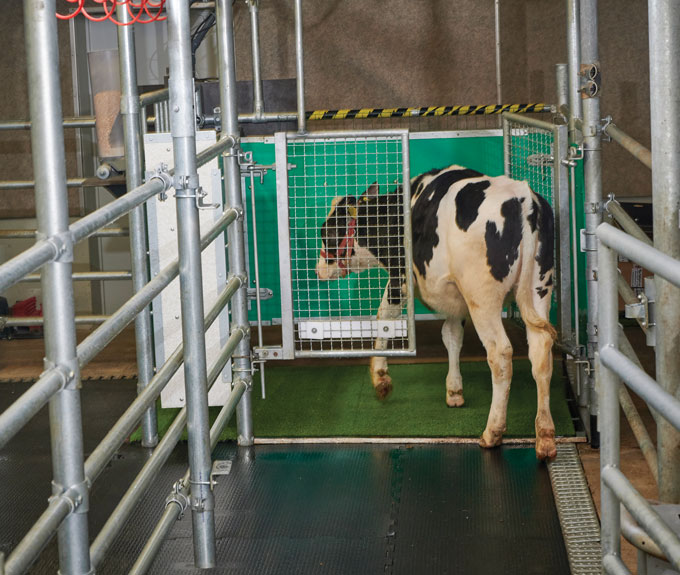Readers ask about the James Webb Space Telescope and cosmic cannibalism
Worth the waitThe James Webb Space Telescope, which has been in development for


Worth the wait
The James Webb Space Telescope, which has been in development for more than 30 years, will soon launch and explore new cosmic questions that have cropped up since the telescope was first conceived, Lisa Grossman reported in “The origami satellite” (SN: 10/9/21 & 10/23/21, p. 26).
Once operational, the James Webb Space Telescope will survey planets orbiting small, cool stars called M dwarfs, Grossman reported. Reader Bert Latamore asked why the telescope will focus on those planets instead of ones orbiting stars similar to our sun.
Planets in the habitable zones of M dwarfs are easier to discover and observe, Grossman says. Since M dwarfs are smaller and cooler than sunlike stars, planets in their habitable zones cross in front of, or transit, the stars more frequently. When a planet does transit such a star, more starlight can filter through the planet’s atmosphere (if it has one), allowing astronomers to measure the atmosphere’s composition, she says.
Surveying M dwarf systems is only a first step, Grossman says. “Ultimately, scientists would like to look at rocky planets orbiting stars similar to our sun. Using Webb to study M dwarfs’ planets will help scientists learn how to make important observations, and what to look for when we can study the really exciting worlds,” she says.
Grossman reported that Webb’s home in space will be a gravitationally fixed point called L2 that is about 1.5 million kilometers from Earth, beyond the reach of scientists if something were to go awry. Reader Bruce Joffe wondered how Webb will be able to orbit around this point since there is no massive celestial body nearby to keep the telescope in place.
Objects that orbit L2 are nearly — though not completely — stable, says astronomer Scott Friedman of the Space Telescope Science Institute in Baltimore, who is in charge of Webb’s postlaunch choreography. Webb and other satellites that orbit L2 need propulsion to maintain their positions. “For Webb, we will execute what we call station-keeping maneuvers every 21 days,” Friedman says. The telescope’s thrusters will fire to correct its position and maintain its L2 orbit.
Reader Malcolm K. Cleaveland wondered why it would be impossible for scientists to service Webb if something were to go wrong, given our increasing space capabilities — including a proposed lunar base.
“L2 is about four times farther from Earth than the moon is, even at the moon’s farthest distance,” Grossman says. “Even if we have a lunar base someday, and I’m not convinced that we will during Webb’s limited operational lifetime, it would still be a small step toward L2.”
Holy cow!
Researchers trained cows to pee in a stall (shown below). Such “MooLoo training” on a large scale could help reduce pollution, Maria Temming reported in “Cows use stalls when nature calls” (SN: 10/9/21 & 10/23/21, p. 24). Twitter user @Natas4President was amused by the story, writing: “MooLoo trainer on your resume looks fabulous from the University of Mootivation.”

Cosmic cravings
Astronomers may have pieced together the first firm evidence of a theorized type of supernova, in which a star gulps down a compact object — such as a black hole or neutron star — and the object engulfs the star’s core, causing the star to explode, Adam Mann reported in “Double cannibalism sparks explosion” (SN: 10/9/21 & 10/23/21, p. 6).
The purported black hole or neutron star in this binary system was the remnant of a star’s supernova death, Mann reported. Reader Richard Freeman wondered how the living star in the binary survived its companion’s explosive demise.
Though it might seem strange for anything to survive so close to a massive stellar explosion, it does happen, Mann says. “The majority of stars are born in double or even triple systems, and the evolution of each partner star affects its companions,” he says.
“But stars are also pretty tough entities, and it’s rather hard to blast them to smithereens from the outside,” Mann says. This is because a star is made of an extremely dense core, surrounded by loosely held plasma and hot gas. A supernova may temporarily deform a nearby companion star’s gaseous outer shell, but its core is not as easily shaken.




